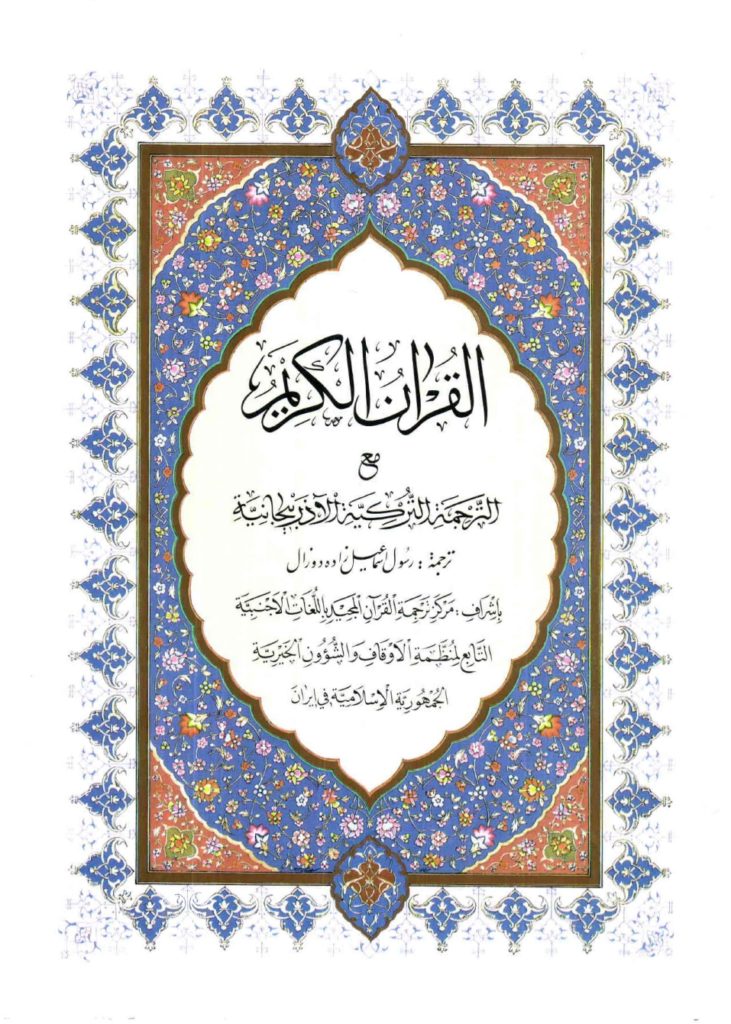One of ten modern translations of the Qur’an into the Azerbaijani language, Rasul Ismail-Zade Duzal’s Qur’an translation has a number of notable features. It is the first “institutional” translation to be published in Azerbaijani, and was produced under the aegis of the Centre for Qur’an Translations into World Languages in Qum, Iran (est. 1994). Prior to the publication of Duzal’s translation the center, one of the main hubs for promoting Qur’an translation into the languages of the world, had already carried out around a dozen translation projects (including translations into Persian, English, Turkish, Spanish, and Russian). The author is of South Azerbaijanian origin, which is part of present-day Iran, and his translation is thus written in Arabic characters and has been popularized mainly in Iran. However, it has also been re-published in the Cyrillic and Latin scripts, the former having been in use since before the turn of the century, and the latter now being the official language of the Republic of Azerbaijan. The translator, Rasul Ismail-Zade Duzal, was born in 1964 in the city of Duzal, which is located on the Iranian side of the Iranian-Armenian border. After receiving his primary education there, he pursued religious learning in the highest Islamic school (hawzeh) in Qum, and later graduated from the Faculty of Law at Tehran University. Through his associations with a number of different international institutions, such as the Islamic Culture and Relations Organization which has its headquarters in Tehran, Rasul Ismail-Zade Duzal has also lectured in many Iranian universities. The first edition of his translation was published in 1999, and contained the original Arabic text and Duzal’s Azerbaijani interpretation. It is prefaced by a very short introduction from the publisher (in both Arabic and Azerbaijani), signed by the head of the Center, Dr Muhammad Naqdi, which mainly consists of standard statements on the Qur’an’s untranslatability and other limits of interpretation. The text itself is published in a parallel-page format, with the Arabic presented on one page, and the Azerbaijani on the following one. The strategy behind the translation seems to be to give a kind of grammatical interpretation of the original Arabic text. The translation is generally literal, word for word, with the addition of two kinds of insertions, in round brackets (for explanations) and square brackets (for interpolations). Commentary on the text, which is placed as footnotes, is rare, and mostly devoted to domestic cultural conceptions which would be hard to convey in a literal translation. A good example of this can be seen in Duzal’s treatment of Q 2:104, where word rāʿinā is explained with the following comment: “(as the word used by Prophet’s opponents in a negative sense, though literally it means ‘care about us’).”
No tafsīrs are mentioned in Duzal’s comments and explanations, which means that it is not clear which exegetical corpus underpins his translatorial approach, but it is obvious that Shi’i interpretations were preferred. This can be clearly seen in his translation of the ritual ablution verse (Q 5:6), where the maskh rite, i.e. wiping the legs with wet hands, is prioritized over another reading, i.e. washing the legs in the same way as hands. This Shi’i tendency can be seen even more clearly in Q. 4:24, which discusses the legality of relationships with various classes of women, where the phrase “fa-mā is’tamtaʿtum bi-hi min-hunna” often translated along the lines of “whatever you enjoy from them”, is explained as müvəkiti nikəh, i.e. “temporary marriage”, a form of the matrimonial contract widely promoted by some Shi’i authorities and usually considered to be unlawful by Sunnis. The style of the text seems to follow modern literary Azerbaijani norms, although some of the verbs and nouns follow archaic grammatical structures, and is particularly representative of the language used in the Iranian part of Azerbaijan. Some words with Arabic roots are also represented in a different way: for example, Duzal uses təqvaliləri for the Arabic muttaqīn (in most other Azerbaijani translations, müttəqilər is used); hidayət for the Arabic hudā, etc. In contrast to some earlier Azerbaijani translations produced in South Azerbaijan, the name of God is preserved in the form “Allah” rather than being rendered as “Tanrı” (as it is, for example, in Ahmad Kaviyanpur’s 1992 translation). Soon after its appearance in Arabic script, the translation was republished in Cyrillic and Latin scripts, in a number of separate editions (dating to the 2000s) and also in the pages of the Qum-based journal Terjuman-e Wahy (“The Translator of the Revelation”). Widely promoted among Iranian Azerbaijanians, the translation, however, did not attain any significant popularity in the Republic of Azerbaijan, in contrast to other translations published in Turkey (whether by the Directorate of Religious Affairs or the Turkish Diyanet Foundation) or Saudi Arabia (by the King Fahd Qur’an Printing Complex). The text is also available online via some Iranian resources, but finding it and working with it require at least a basic knowledge of modern Persian, which means that the ultimate impact of this translation remains limited to those pursuing religious learning in Iran only.
Mykhaylo Yakubovych



